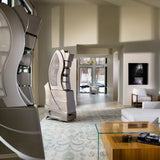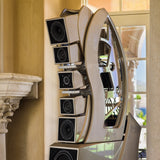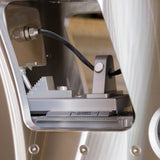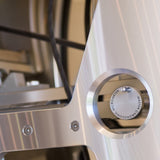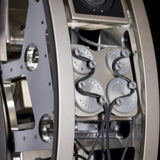Wilson Audio
Wilson Audio Wamm Master Chronosonic Loudspeaker System
The WAMM Master Chronosonic is the most time-domain correct loudspeaker in Wilson’s history. It plumbs new depth in terms of technology and execution. From drivers to cutting-edge composites, from crossover technology to perfecting geometries. Most importantly, the adjustability in the time domain is precise down to five millionths of a second for any installation—accuracy heretofore only achievable in the theoretical domain.
WAMM Master Chronosonic
Auspicious Beginnings
In the late seventies, Dave began experimenting with adjustable modular arrays. Empirical listening combined with careful measurements revealed that the ability to adjust the loudspeaker’s drivers within the time domain—specifically as it related to aligning the leading edge transients of each of the individual drivers—was critically important. He realized that even tiny errors in the alignment of the drivers in relationship to the listener caused obvious sound-quality degradation. Through the late seventies and into the dawn of the eighties, he continued to explore these ideas, as well as modify and evolve his loudspeaker prototype. During this time, Dave applied for and acquired a patent for adjustable-propagation-delay loudspeaker arrays. More importantly, he continued to develop and refine his proprietary method for the accurate measurement of time-domain deviations.
By late 1981, his hard work had culminated in the form of his first assault on the state-of-the- art of believable music reproduction. He called his new loudspeaker the Wilson Audio Modular Monitor—the WAMM. The WAMM was a multi-module loudspeaker, each module physically adjustable in relationship to the other modules in the time domain. It was the physical manifestation of Dave’s theories surrounding the lifelike recreation of music.
To call the original WAMM a breakthrough is an exercise in understatement.
It’s About TimeTM
The measure of engineering success of any loudspeaker is its verisimilitude to acoustical (un-amplified) music in a loudspeaker. There are two terms that describe the essential character of live music: Dynamic Contrast and Harmonic Expression. In order to achieve either of these, a loudspeaker must be correctly aligned in the time domain.
Most designers understand the importance of flat frequency response accuracy in the spectral domain. Some also tout the importance of phase coherency, an aspect of music reproduction that blind empirical testing has shown to be less significant than accuracy in either the spectral or temporal domain. Seemingly, very few truly understand the importance of the time domain.
In addition linear frequency response, preserving tonality and the complex textures of musical instruments requires the accurate preservation of Temporal Coherence. Subtle micro-timing clues, which are created by a variety of structures and spaces, are inextricable to the true nature of an instrument. It is the relationship of these overlapping waveforms in the time domain that produces an instrument’s tonal signature. If accurate reproduction is the goal, it is vital that the timing relationships between these closely spaced contributory sounds are preserved.
Ongoing research has confirmed that the ear/brain mechanism is much more sensitive to timing coincidence errors than once believed. Indeed, timing accuracy is as important as frequency response accuracy and far more important than phase coherence. Ordinary people can hear timing coincidence errors as small as ten-millionths of a second in the five to ten kHz octave. Most multi-driver speakers with fixed, flat baffles, positioned perpendicular to the floor, are incapable of correct alignment in the time domain on purely geometrical grounds. Most loudspeakers of this type introduce timing errors on the order of hundreds of microseconds at the listener’s ear.
The Master Chronosonic is capable of driver-to-driver time-domain accuracy heretofore possible only in the theoretical domain. Via the Master Chronosonic Micrometer System, module movement is refined down to a previously inconceivable two microseconds (two-millionths of a second) per adjustment increment. The hallmark of the Master Chronosonic’s technical achievement, and the principal factor central to its unique ability to sound utterly lifelike, is the Master Chronosonic Adjustable Array.
Tweeter
In conjunction with WAMM and Alexx, Daryl Wilson and Wilson’s team of engineers revisited the current state of the art of tweeter technology. The research included tweeter domes constructed of diamond and beryllium. After exhaustive testing and listening, Wilson’s engineering team concluded that the silk-dome Convergent Synergy Tweeter remains the most musically authentic and emotionally satisfying tweeter yet tested. Yet again, Wilson’s unique holistic approach to design was at play here— employing a combination of carefully conducted measurements and empirical listening. The Wilson-designed Convergent Synergy was further and specifically evolved and developed for the Master Chronosonic, and is designated as the Mark V version.
Woofers
Unlike the original WAMM, which required a subwoofer to cover the bottom octaves, the Master Chronosonic is a true full-range design. In order to achieve Dave’s design goals, it was decided that an all-new approach in the area of bass drivers was needed. The design imperative was to maximize transient integrity, speed, and bottom-octave extension. The all-new 10.5 and 12.5 inch woofers were designed from the ground up to complement each other, specifically addressing the challenges presented by using two woofers with different diameters in a single en- closure. These new woofers incorporate all of Wilson’s latest thinking on accurate and musical low-frequency music reproduction. The Master Chronosonic’s heroic bass enclosure, with its unmatched ability to control and eliminate unwanted resonances, is the ideal platform in which to mount the Master Chronosonic’s bass drivers.
Midrange
Wilson’s MTM configurations, which feature time-domain adjustability, have always been far more sophisticated, complex, and musical than competing designs. Rather than mounting the three drivers that make up the MTM in a flat baffle, each driver is mounted in its own module. The modules are, in turn, adjustable relative to each other, which facilitates alignment in the critical time domain within the loudspeaker array. Another advantage to modularity is the ability to optimize the construction of each module, with the specific combinations of composites best suited to the needs of each driver.
Led by Dave, Wilson Audio’s engineering team re-imagined the MTM geometry for the Master Chronosonic. The midrange is divided between two drivers, a seven-inch and four-inch for both the bottom and top portions of the MTM array. Each of the two drivers cover a portion of the midband area. The seven-inch is a bespoke modified version of the celebrated Wilson mid, first introduced in the Alexandria Series 2. The four-inch is an eminently musical driver that covers the important upper-midrange area up to the point where it crosses over to the Convergent Synergy Tweeter. The frequencies covered by the two drivers are therefore both expanded upward and downward in frequency when compared to previous Wilson designs—the two together covering a broader portion of the midrange. Furthermore, each driver is optimized for the portion of the midband best suited to its unique strength. Dave masterfully blended the two sets of mid drivers, ensuring that they perform seamlessly and coherently together.
Aerospace-Grade Aluminium
The infrastructural gantry supporting the time-domain adjustability—the Master Chronosonic Micrometer—is constructed from aerospace-grade aluminium. One of aluminium’s virtues is modulus of elasticity. This quality, combined with relatively low mass, resistance to corrosion, and low toxicity, make it an excellent material to form the adjustable support structure for the modules, ensuring that the overall rigidity of the module launch points is maintained. Because even the best aluminium is not well suited for driver interface or module damping, the Master Chronosonic employs Wilson’s composites, X-, W-, and S-Materials in these locations.
The aluminium is finished in a beautiful prismatic machined pattern, calling to mind the Guilloché finish of the finest Swiss watches.
Architectural Details
The woofer baffle is angled toward the upper array at 6.5 degrees, which improves the time alignment of the woofers in relationship to the listener’s position. The open architecture of the Master Chronosonic’s upper gantry minimizes stored sonic energy behind the upper modules. The resistor-access panel features a new approach with improved access. The resistor heatsinks are custom built for the Master Chronosonic, each chosen for its combination of sonic and thermal performance.
Even the fabric grilles that optionally cover each of the module’s drivers are hand-built using ultra-low-acoustical-impedance material.
The rear-firing module is optimized for ceiling heights normally found in domestic environments and increases spatial retrieval and overall resolution. The tweeter was specifically designed for this application. It utilizes the rear wave chamber from the Mark V version of the Convergent Synergy Tweeter. The 5” midrange was also specifically developed for this application.
A new system of cable dressing, which features rotary cable tensioners, makes its debut in the Master Chronosonic. While the new system is beautiful, the design was engineered to reduce the deleterious effects of magnet ostriction. Similarly, custom-made enclosure-breach-point hardware, which terminates each corresponding cable into the rear of its respective enclosure, minimizes wire connection points throughout the loudspeaker system, and reduces degradation throughout the wired signal path.
Unquenchable Curiosity
Dave Wilson is animated by an unquenchable curiosity, which, in turn, fuels his boundless yearning for discovery. He has spent the better part of his adult life engaged in the difficult and demanding work of turning his intensely ambitious dreams into remark- able physical creations. Since he can remember, he has been obsessed with the sound of live music. Even now, he continues to ask this simple question: Why do certain transducers sound more like the live musical event? What is it about certain combinations of cabinet materials, crossover elements, and drivers—and even the geometric arrangement of those drivers— that produces an intellectually convincing and emotionally satisfying facsimile of live music?
Somewhat unique in the high-end loudspeaker world, Dave is a natural scientist. He is dedicated to the rigorous application of the scientific method. Much of his success has come from his ability to design scientific testing protocols to best answer these questions. Dave understands that the veracity of any given theory is inextricably tied to the result it produces. Put simply, if it sounds real, the science is real.
Standard Colors:
- Galaxy Gray
- GT Silver
- Quartz
- Carbon
- Upgrade & Pearl Colors on Request.
Wilson Gloss™ Colors
Wilson Audio’s commitment to quality begins with the sound of their loudspeakers, but hardly ends there. The physical beauty and craftsmanship of Wilson products have long set the benchmark for the industry. Now, Wilson Audio is excited to introduce an updated and expanded range of colors, which include new Premium Pearl options.
WilsonGloss is a multi-stage process, from a proprietary protective gel coat layer through base color to the final series of clear coats—all followed by meticulous hand polishing. The final finish is unrivaled—even by the world’s greatest automobile manufacturers. Wilson Audo= have updated the selection of upgrade colors, which are available at a modest surcharge. Wilson Audio Premium WilsonGloss includes five new colors, each in a special pearl finish, which involve additional paint steps. WilsonGloss Premium is the ultimate expression of sophistication and beauty.
When combined with a choice of six grille-cloth colors, it’s easier than ever to individually design your Wilson loudspeaker so that it will complement your décor, or express your pride of ownership. Along with standard black grilles, you can alternatively specify Slate Grey, Parchment Grey, Mocha, Blanco White, or Le Mans Blue at no additional cost. With hundreds and hundreds of combinations available, you have the ability to design a Wilson speaker unique to your taste and décor.
For the ultimate in individual expression, Wilson Audio offers Custom Sample Match WilsonGloss finishes. Through your Wilson Dealer, provide them with your wall color, favourite automotive paint, or just about any color sample and we can, for an additional cost, create your loudspeakers in a one-of-a-kind WilsonGloss finish. This service includes on-site storage of custom paint for a period of five years. Contact your Dealer for program requirements and pricing.
| Enclosure Type Woofer | : | XLF port, Adjustable Rear or Front Firing |
| Enclosure Type Midrange | : | Bottom Vent, X-material, S-material baffle |
| Enclosure Type Tweeter | : | Sealed X-Material |
| Gantry | : | Aerospace Aluminum, W-Material Module Interface, X-Material damping |
| Woofers | : | One - 26.67 cm |
| : | One - 31.75 cm | |
| Upper Midrange | : | Two - 10.16 cm |
| Lower Midrange | : | Two - 17.78 cm |
| Main Tweeter | : | One - 2.54 cm Doped Silk Fabric |
| Rear Firing Tweeter | : | One - 2.54 cm Doped Silk Fabric |
| Sensitivity | : | 93.5 dB @ 1W @ 1 meter @1 kHz |
| Nominal Impedance | : | 3 Ω / minimum 1.77 Ω @ 310 Hz |
| Minimum Amplified Power | : | 100 watts per channel |
| Height | : | 214.31 cm w/o spikes |
| Width | : | 53.34 cm |
| Depth | : | 94.93 cm |
| System Weight per Channel | : | 408.23 kg |







